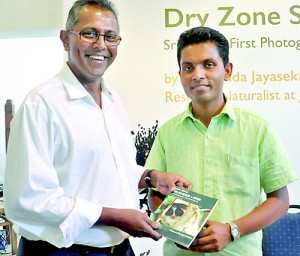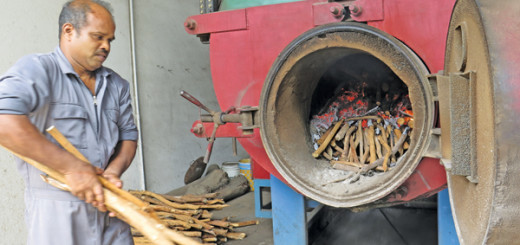Studying our distant cousins
by Jetwing · Published · Updated
Elusive and tiny they are, with overwhelmingly large soulful eyes, and certainly not considered a match for the majestic and enigmatic mammals that Sri Lanka boasts of.

In a corner of the vast Dry Zone, a humble researcher from Polonnaruwa, however, has not only shone the spotlight on this creature but also taken the public, both local and foreign, and schoolchildren into their very secretive world.
As a schoolboy at the Nelumwewa Maha Vidyalaya in the border village of Dimbulagala which had been vulnerable to numerous terrorist attacks during the conflict, Chaminda Jayasekara had oft heard the derogatory saying, “Unuhapuluwage patiya, unuhapuluwata menikaklu” (that to the loris its offspring is a gem, implying that it is an ugly creature).
Having seen the loris once in a way, Chaminda certainly did not think so and this was why when Jetwing Hotels launched a research initiative three years ago, it was not the exotic birds or the majestic elephant that he chose.
He picked the fascinating Dry Zone Grey Slender Loris (Loris lydekkerianus nordicus), for no one seemed too interested in this primate considered one of the smallest.
“We sighted lorises in the thickets in an area owned by the hotel,” says 28-year-old Chaminda who joined Jetwing Vil Uyana in Sigiriya in 2009, after securing a Degree in Travel and Tourism Management from the Rajarata University. He has followed it up with a Post-graduate Diploma in Environment and Regional Development from the Colombo University.
Launching a ‘loris night trail’ on October 20, 2010, his intense interest has led to the collection not only of loads of information on the behavioural patterns of the loris but also heaps of photographs. This has been incorporated in the first-ever ‘Dry Zone Slender Loris – A photographic educational guide’. (See box)
For three years and even now, camera slung around his neck, Chaminda who is the Resident Naturalist of Jetwing Vil Uyana armed with a red light would become nocturnal himself, waiting and watching for his beloved lorises to emerge from their niches in the thickets which dot the three acres. Not only has he been engaging in this passion but he has also opened up the world of the little-known loris to numerous people.
“Do you know that if you shine a white light on lorises it will harm their eyes,” asks Chaminda, pointing out that it is also not effective in locating this small creature. A red light is the ideal for this purpose, as it reflects off their eyes. “Then the eyes of the loris light up like bulbs.”
Chaminda’s search for any titbit of information about the loris has not been limited to Jetwing Vil Uyana. It has taken him also to far-off Veddah territory and remote villages.
From the Veddahs, he has heard folk-tales and legends about how lorises devour the heads of peacocks and are stealthy and silent killers while from villagers have emanated stories about snakes which shout.
The Veddahs who make forays into the jungles daily have not seen a loris in 30 years, he says, adding that many villagers warned him against entering the jungle as there were snakes which made a noise.
“It is the ‘keeeing’ noise of the loris,” smiles Chaminda. “The villagers are referring to the whistle-like call of the loris when they are mating. That is the time you see two lorises, a rare sight, as usually you catch a glimpse only of a solitary loris.”
These beliefs, although not substantiated, add to the mystery that envelopes the loris, according to him.
With the thickets at Jetwing Vil Uyana being the home of the loris and the ‘second home’ of Chaminda, the conservation-conscious management which had earlier been planning to expand the hotel, has shelved plans to build more rooms there.
Declared the first ‘Loris Conservation Site’ complemented by a Conservation Centre, many have been the sightings of singles, families and even mothers with not just one baby but also twins which have resulted in both the BBC and National Geographic featuring it.
For Chaminda, there is only simple logic why he ‘pursues’ the loris.
“Meka angata bandhunata passey galaweemak nae,” he says without pretence, adding that once the passion for this animal gets into one’s being there is no turning back.
This is what keeps drawing him, from his comfortable and warm bed, not only in the night but even at the crack of dawn, as early as 3.30 a.m. when dew has settled on everything around, there is absolute stillness and most animals are deep in slumber, with only the loris active in the wild.
A guide to Dry Zone Loris
It was a book launch with a difference at the Barefoot Gallery in Colombo on Wednesday.
Among the eminent gathering of invitees and the media were 12 girls and boys in their white uniforms from the Kimbissa Vidyalaya who had the privilege of being presented the ‘Dry Zone Slender Loris – A photographic educational guide’ by the author himself.
This slim, colourful guide, packed with photographs and little-known information, after several years of research and exploration, is not at all scientific but easy to understand and grasp by anyone, even a small child.
Interesting facets linked to the loris emerge – how the name ‘loris’ is derived f

rom the Dutch ‘Loeris” which means a jester, joker or dud and also an unorthodox character who does things to make others laugh and merry.
Commending the study of lorises by Chaminda, it is Prof. Devaka Weerakoon of the Colombo University’s Department of Zoology, who stated at the book launch that many of us have seen monkeys but not lorises because they are extremely rare primates and are slow and very shy.
There are 91 species of indigenous mammals in Sri Lanka, of which 21 are endemic; 12 species which have been introduced to the country; and 30 species of marine mammals, he says.
Of the five species of primates, the Purple-faced Langur, the Toque Macaques and the Red Slender Loris are endemic while the Grey Langur and the Grey Slender Loris are found both in Sri Lanka and southern India, according to Prof. Weerakoon.
What Prof. Weerakoon finds interesting about Chaminda and his book are that although many may take up the work he is doing as a job and not as a passion, Chaminda is passionate about his work.
While previous work on primates has focused on taxonomy and distribution, Chaminda has studied the behaviour of the loris in its natural habitat, according to him.
A glance through the colourfully-illustrated guide gives an insight even on simple things like one finger of the loris’s hind limb having a long fingernail while the rest are flat and round. How lorises have the “special feature” of being able to manipulate their limbs in any direction while moving, which helps them to get away swiftly from danger and how unlike other primates they have no tail.
The guide points out the fact that though the Slender Loris may be found in almost every ecosystem in the country, the Northern Grey Slender Loris has been recorded only in the Dry Zone, with the locations so far includingAnuradhapura, Polonnaruwa, Talawa, Mannar, Wilachchiya, Thammennawa, Sigiriya and Dambulla.
Mature adults mark their territory with urine, laughs Chaminda, adding that he has seen some touching the marked areas with their hands and thus expanding their territory as they grip other branches to move on.
Lamenting about the threats to the loris, he cites habitat destruction through slash-and-burn (chena) cultivations as a major issue while pointing out that in some areas like Polonnaruwa and the Sigiriya rock they face electrocution by the high-tension wires.
Underscoring the need to conserve the loris, he suggests identifying and protecting their habitats and awareness campaigns as essential.
Chaminda and his team have not gone unnoticed with regard to their loris work. They bagged the first prize in the environmental category at the World Travel and Tourism Council Awards in April and the PATA Grand Award for Environment which has been announced but will be presented in September.
The best compliment, however, came from Prof. Weerakoon last Wednesday, when he said that Chaminda’s efforts have helped to shed light on a primate about which very little is known. “We do need to get to know them, for lorises, primitive primates they may be and as tiny as eight inches but they are the distant cousins of humans.”
The book launch was graced by Jetwing Hotels Chairman Hiran Cooray making it clear that the management was not only fully supportive of Chaminda and his work with the lorises but also conservation efforts which include the protection of this primate; Jetwing Hotels Managing Director Ruan Samarasinghe who saw Chaminda as “a true champion of conservation” and Jetwing Vil Uyana Resident Manager Indika Gamage.




